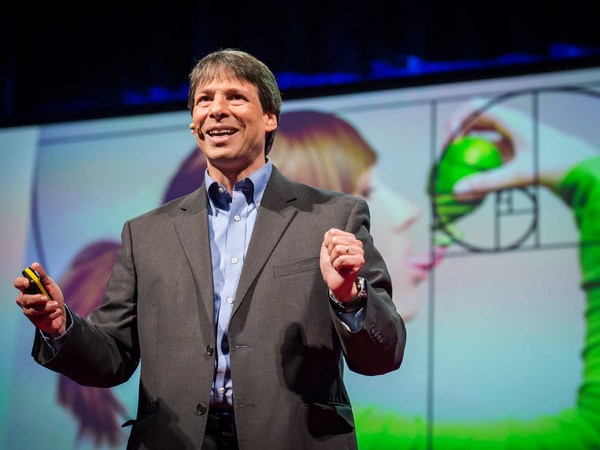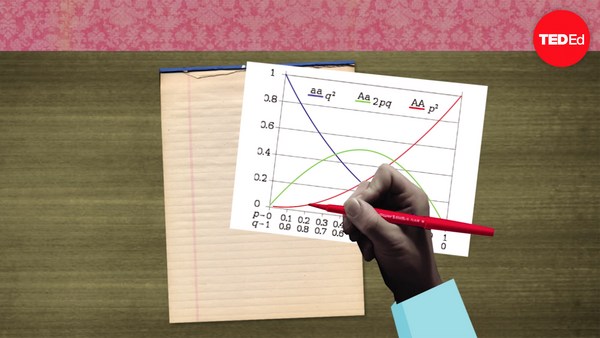Imagine you're in a bar, or a club, and you start talking, and after a while, the question comes up, "So, what do you do for work?" And since you think your job is interesting, you say, "I'm a mathematician." (Laughter) And inevitably, during that conversation one of these two phrases come up: A) "I was terrible at math, but it wasn't my fault. It's because the teacher was awful." (Laughter) Or B) "But what is math really for?" (Laughter) I'll now address Case B. (Laughter)
When someone asks you what math is for, they're not asking you about applications of mathematical science. They're asking you, why did I have to study that bullshit I never used in my life again? (Laughter) That's what they're actually asking. So when mathematicians are asked what math is for, they tend to fall into two groups: 54.51 percent of mathematicians will assume an attacking position, and 44.77 percent of mathematicians will take a defensive position. There's a strange 0.8 percent, among which I include myself.
Who are the ones that attack? The attacking ones are mathematicians who would tell you this question makes no sense, because mathematics have a meaning all their own -- a beautiful edifice with its own logic -- and that there's no point in constantly searching for all possible applications. What's the use of poetry? What's the use of love? What's the use of life itself? What kind of question is that? (Laughter) Hardy, for instance, was a model of this type of attack.
And those who stand in defense tell you, "Even if you don't realize it, friend, math is behind everything." (Laughter) Those guys, they always bring up bridges and computers. "If you don't know math, your bridge will collapse." (Laughter) It's true, computers are all about math. And now these guys have also started saying that behind information security and credit cards are prime numbers. These are the answers your math teacher would give you if you asked him. He's one of the defensive ones.
Okay, but who's right then? Those who say that math doesn't need to have a purpose, or those who say that math is behind everything we do? Actually, both are right. But remember I told you I belong to that strange 0.8 percent claiming something else? So, go ahead, ask me what math is for.
Audience: What is math for?
Eduardo Sáenz de Cabezón: Okay, 76.34 percent of you asked the question, 23.41 percent didn't say anything, and the 0.8 percent -- I'm not sure what those guys are doing. Well, to my dear 76.31 percent -- it's true that math doesn't need to serve a purpose, it's true that it's a beautiful structure, a logical one, probably one of the greatest collective efforts ever achieved in human history. But it's also true that there, where scientists and technicians are looking for mathematical theories that allow them to advance, they're within the structure of math, which permeates everything.
It's true that we have to go somewhat deeper, to see what's behind science. Science operates on intuition, creativity. Math controls intuition and tames creativity. Almost everyone who hasn't heard this before is surprised when they hear that if you take a 0.1 millimeter thick sheet of paper, the size we normally use, and, if it were big enough, fold it 50 times, its thickness would extend almost the distance from the Earth to the sun. Your intuition tells you it's impossible. Do the math and you'll see it's right. That's what math is for.
It's true that science, all types of science, only makes sense because it makes us better understand this beautiful world we live in. And in doing that, it helps us avoid the pitfalls of this painful world we live in. There are sciences that help us in this way quite directly. Oncological science, for example. And there are others we look at from afar, with envy sometimes, but knowing that we are what supports them. All the basic sciences support them, including math. All that makes science, science is the rigor of math. And that rigor factors in because its results are eternal.
You probably said or were told at some point that diamonds are forever, right? That depends on your definition of forever! A theorem -- that really is forever. (Laughter) The Pythagorean theorem is still true even though Pythagoras is dead, I assure you it's true. (Laughter) Even if the world collapsed the Pythagorean theorem would still be true. Wherever any two triangle sides and a good hypotenuse get together (Laughter) the Pythagorean theorem goes all out. It works like crazy. (Applause)
Well, we mathematicians devote ourselves to come up with theorems. Eternal truths. But it isn't always easy to know the difference between an eternal truth, or theorem, and a mere conjecture. You need proof. For example, let's say I have a big, enormous, infinite field. I want to cover it with equal pieces, without leaving any gaps. I could use squares, right? I could use triangles. Not circles, those leave little gaps. Which is the best shape to use? One that covers the same surface, but has a smaller border. In the year 300, Pappus of Alexandria said the best is to use hexagons, just like bees do. But he didn't prove it. The guy said, "Hexagons, great! Let's go with hexagons!" He didn't prove it, it remained a conjecture. "Hexagons!" And the world, as you know, split into Pappists and anti-Pappists, until 1700 years later when in 1999, Thomas Hales proved that Pappus and the bees were right -- the best shape to use was the hexagon. And that became a theorem, the honeycomb theorem, that will be true forever and ever, for longer than any diamond you may have. (Laughter)
But what happens if we go to three dimensions? If I want to fill the space with equal pieces, without leaving any gaps, I can use cubes, right? Not spheres, those leave little gaps. (Laughter) What is the best shape to use? Lord Kelvin, of the famous Kelvin degrees and all, said that the best was to use a truncated octahedron which, as you all know -- (Laughter) -- is this thing here! (Applause) Come on. Who doesn't have a truncated octahedron at home? (Laughter) Even a plastic one. "Honey, get the truncated octahedron, we're having guests." Everybody has one! (Laughter)
But Kelvin didn't prove it. It remained a conjecture -- Kelvin's conjecture. The world, as you know, then split into Kelvinists and anti-Kelvinists (Laughter) until a hundred or so years later, someone found a better structure. Weaire and Phelan found this little thing over here -- (Laughter) -- this structure to which they gave the very clever name "the Weaire-Phelan structure." (Laughter) It looks like a strange object, but it isn't so strange, it also exists in nature. It's very interesting that this structure, because of its geometric properties, was used to build the Aquatics Center for the Beijing Olympic Games.
There, Michael Phelps won eight gold medals, and became the best swimmer of all time. Well, until someone better comes along, right? As may happen with the Weaire-Phelan structure. It's the best until something better shows up. But be careful, because this one really stands a chance that in a hundred or so years, or even if it's in 1700 years, that someone proves it's the best possible shape for the job. It will then become a theorem, a truth, forever and ever. For longer than any diamond.
So, if you want to tell someone that you will love them forever you can give them a diamond. But if you want to tell them that you'll love them forever and ever, give them a theorem! (Laughter) But hang on a minute! You'll have to prove it, so your love doesn't remain a conjecture.
(Applause)





